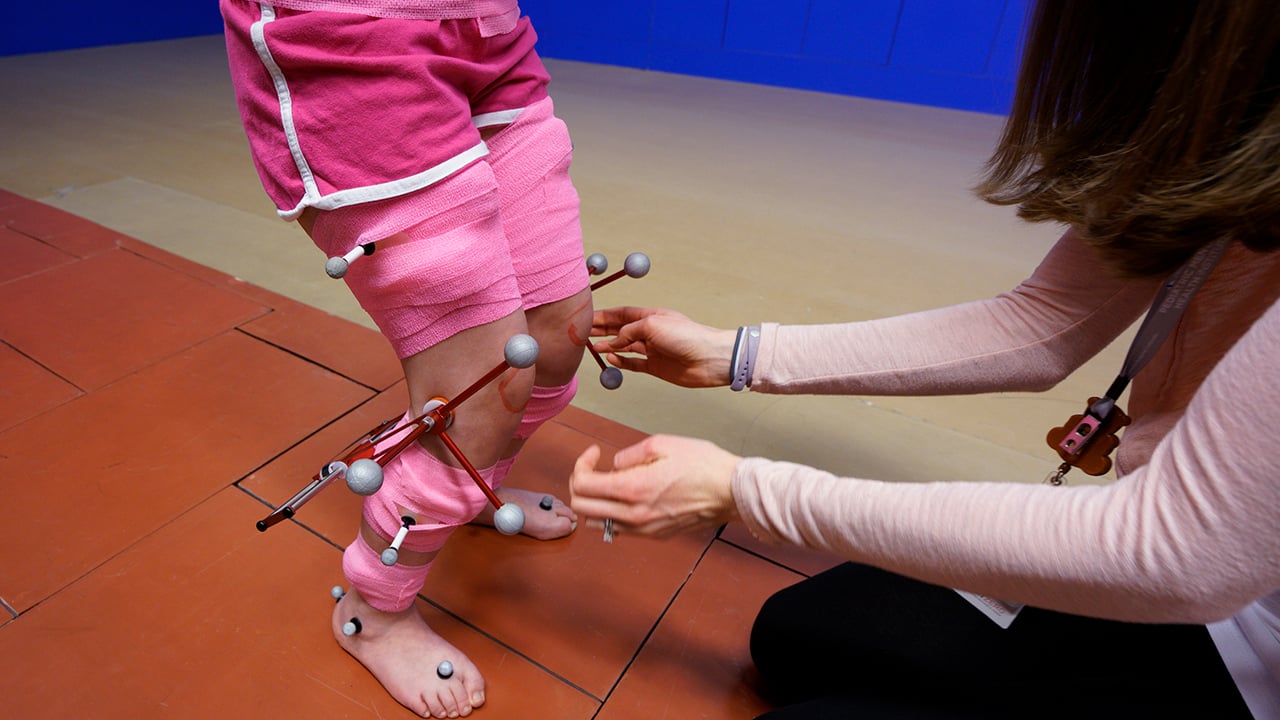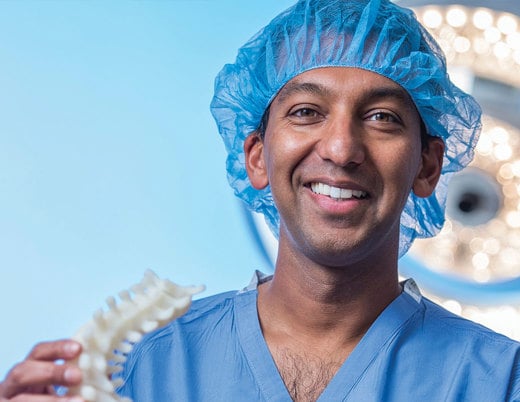Key takeaways
-
Rectus femoris transfers with or without hamstring lengthening has been shown to help stiff-knee gait.
-
Few studies have addressed if either surgical approach can improve hip kinematics.
-
Our researchers found no change to hip kinematics with either surgery.
Background: rectus femoris surgery for stiff-knee gait in children with cerebral palsy
Cerebral palsy is a chronic condition caused by disruptions in one or more areas of the brain, affecting an individual’s muscle tone and coordinated movement.
The rectus femoris muscle contributes to hip flexion and knee extension throughout the gait cycle (the repeated phase of movement propelling a body forward). Children with cerebral palsy may exhibit over-activity or abnormal timing of this muscle during gait, leading to a stiff-knee gait pattern where the dynamic knee range of motion and peak knee flexion are decreased during the swing period.
Researchers from the Orthopedics Institute at Children’s Hospital Colorado sought to determine if a rectus femoris transfer orthopedic surgery, with or without hamstring lengthening, creates kinematic changes at the hip. The Orthopedics Institute includes the Musculoskeletal Research Center and the Center for Gait and Movement Analysis (CGMA), one of only 20 nationally-accredited clinical motion laboratories in the U.S. and the site of the current study.
They hypothesized a rectus femoris transfer would increase peak hip extension at terminal stance and decrease peak hip flexion in terminal swing.
Study authors included Jason T. Rhodes, MD; Sayan De, MD; James Carollo, PhD; Alex Tagawa, BS; Lucas Moore; Amy Holcomb; Patrick Carry, PhD; Austin Skinner and Scott Miller.
Surgical techniques to address stiff-knee gait
Rectus femoris release
- Post-operative results reported in studies included:
- Increased knee flexion
- Varied hip results
Rectus femoris transfer
- An option to rectus femoris release
- Preserves rectus femoris function in early hip flexion
- Increases knee flexion during swing period
- May create kinematic changes at hip, knee
- Studies found pre-operative evaluation of hip power and rotation using 3D motion analysis to be an important predictor of outcomes, identification of candidates
- Post-operative results reported in studies included:
- Treated stiff-knee gait
- Improved knee range of motion
- Improved peak knee flexion during swing
- Limited studies reporting effects on:
- Hip motion of sagittal plane (flexing and extending)
Rectus intramuscular lengthening
- Post-operative results reported in studies found technique as effective as rectus femoris transfer
- Long-term effects not evaluated in this study
Rectus femoris transfer with hamstring lengthening
- Often performed at same time if hamstring contracture impedes full knee extension
- Dual action of both muscles helps control combined sagittal plane movements of lower body
Methods: review of hip and knee changes after rectus femoris transfer with or without hamstring lengthening

After exclusions, 47 patients (66 legs) were included in the study.
Laboratory methods and data processing
To minimize the two different processing protocols used over the study period, participant data was reprocessed using the current clinical protocol at Children’s Colorado. Maximum and minimal values were collected, and a mean was taken.
Terminal stance phase was defined as second half of the single limb support task from heel-off to contralateral initial contact. Variables collected included:
- Peak hip extension (minimum hip flexion/extension)
- Peak hip abduction (maximum hip abduction/adduction)
- Peak hip internal/external rotation
- Peak knee flexion (maximum knee flexion)
The entire cohort was divided into a final group including patients considered to have a positive change in walking performance (Gait Deviation Index of ≥ 5 points).
Statistical analysis
- Pre- and post-operative gait analyses identified kinematic differences at hip and knee
- Changes compared to normalized values of aged-matched normal gait patterns from Center for Gait and Movement Analysis
- Secondary analysis tested for:
- Changes differing between subjects who underwent hamstring lengthening vs. those who did not
- Kinematic changes differing between subjects who demonstrated positive change in overall walking performance vs. those who did not
Results: no significant hip changes after rectus femoris transfer with or without hamstring lengthening
Study authors found that hamstring lengthening was the most common procedure accompanying a rectus femoris transfer. There was a 2.1 years average between pre- and post-surgical gait analysis. Additionally, there were no statistically significant differences in demographics for groups who underwent rectus femoris transfer alone versus combined with hamstring lengthening, and groups with positive change in walking performance and those with no change.
Key findings included:
- Rectus femoris transfer did not change kinematics at the hip, but maximum knee flexion during swing period increased
- Changes in hip extension during terminal stance phase significantly different between rectus femoris transfer and hamstring lengthening vs. rectus femoris transfer alone
- Children whose stiff-knee gait did not improve had increased hip external rotation during terminal stance and swing, and greater hip extension during terminal stance, compared to those whose stiff-knee gait improved

Discussion and conclusion: Children with cerebral palsy requiring rectus femoris transfer to treat stiff-knee gait should not expect changes in their hip motion after surgery
Study authors concluded that a rectus femoris transfer with or without hamstring lengthening:
-
Hamstring procedures done concurrently with rectus femoris transfer or release do not significantly affect hip kinematics during walking
-
If hip flexion contracture or lack of hip extension at terminal stance are concerns, consider other hip flexor surgical procedures or other causes leading to excessive hip flexion during walking
Additional studies should examine if a rectus femoris transfer could help correct an increased hip flexion at terminal swing in individuals who also had a positive Ely test.





 720-777-0123
720-777-0123










